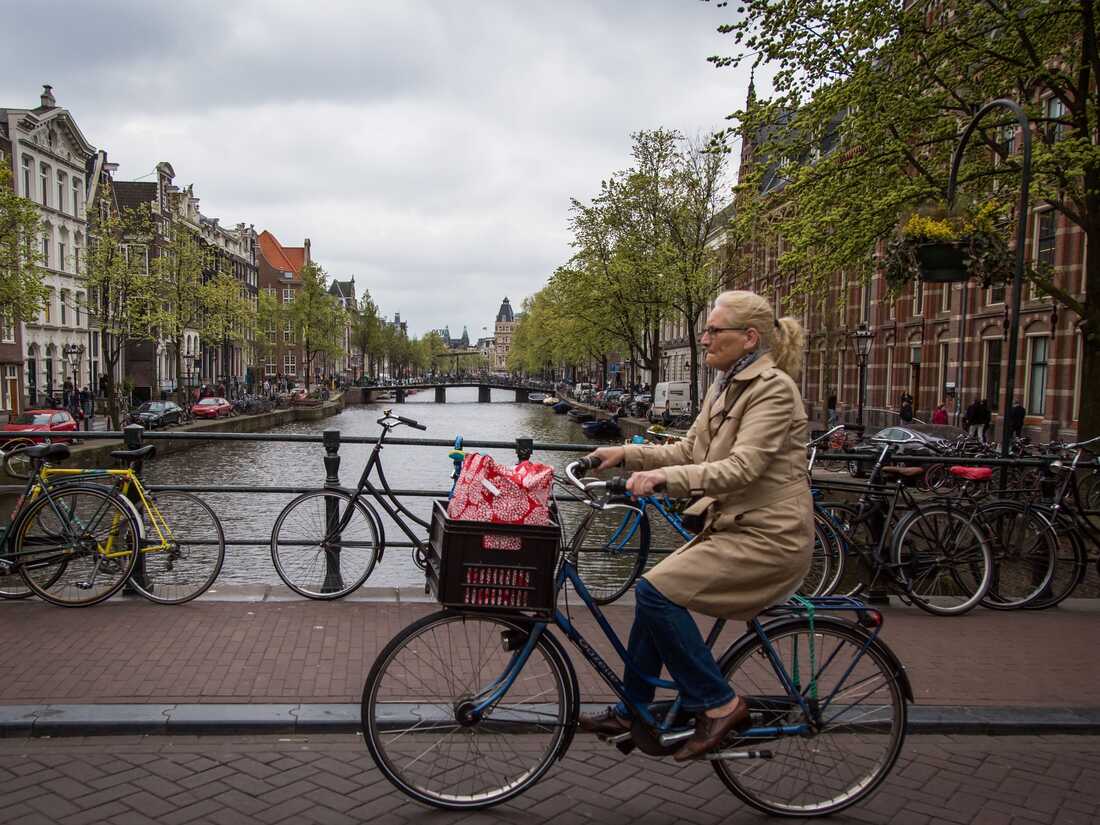
Will she end up with her bike in that canal? Getty Images, AURORE BELOT remove caption
switch to caption Getty Images, AURORE BELOT
Will she end up with her bike in that canal?
Getty Images, AURORE BELOT You certainly anticipate aquatic life and the occasional piece of rubbish when you peek into a stream. But in many large metropolises, it is actually possible that a startling number of bicycles could be hidden beneath the surface of any canal.
A rental company in Rome had to halt operations because too many of its bicycles were dumped into the Tiber, while bike sharing companies in Southern China were forced to fish out thousands of their rental bikes from waterways.
Each year, 15,000 bicycles are removed from Amsterdam’s canals, an increase over previous years.
Why have so many of these wheeled ships fallen into the sea? And once a bike has changed terrain, what happens to it?
Two Wheels Good: The History and Mystery of the Bicycle is written by Jody Rosen, a contributor to the New York Times Magazine. To solve this maritime puzzle, he joined All Things Considered.
This conversation has been condensed and made more concise.
HIGHLIGHTS OF THE INTERVIEW On the global reach of this trend
I kind of first became aware of this problem when I started to see news reports from various sources. In New York City, where I currently reside, a Citi Bike showed up at a docking station covered in oysters and barnacles. I started doing some internet research using Google and found that this was a highly common occurrence on at least three continents. Therefore, there is no doubt that there is a widespread issue; nevertheless, because the issue is disguised, I believe that the scope of the issue is by definition unknown. There are bicycles that are literally submerged under the world’s waterways, after all. Therefore, by definition, it is not anything about which we can ever have conclusive or trustworthy statistics.
The most popular bikeshare program in New York City is Citi Bike (IMG: 3). Image courtesy of Dimitrios Kambouris/Getty remove caption
switch to caption Image courtesy of Dimitrios Kambouris/Getty
The most popular bikeshare program in New York City is Citi Bike.
Image courtesy of Dimitrios Kambouris/Getty On the current online documentation for this
There is just a certain thrill and a certain free zone in watching the bicycle go in there and sink into the sea. And, mind you, I don’t say that because I did it myself. This is a technique that is extensively documented online, for example on YouTube. There are numerous movies available where individuals toss bikes into water while filming it for amusement and pleasure.
ENVIRONMENT Thus, it is unquestionably a factor. However, there are other other forms of graffiti that surround this that I find to be fascinating. The city of Amsterdam, where there are so many bicycles, is undoubtedly one of the most prominent cycling cities in the world. There are also a ton of canals. It’s kind of the perfect setting for bicycle dunking or drowning. And historically, it has been such a significant issue that the city now employs a core of “bicycle fisherman” to dredge the bicycles out of the canal.
Regarding the contribution of bike sharing programs to this growth
That is the reason I believe the current, well-known event is occurring. The expansion of these bike programs around the globe, which I believe is positive because cities need more bicycles but also because there are now more of them available. In fact, you can imagine that if it’s a share bike with a bank or other corporate sponsor’s logo on the mudguard rather than, you know, some individual joe-bike, schmoe’s people feel a little bit more impunity and that a potential bicycle drowner would feel less guilt attached to tossing a bike in the water.
There could be a political component to this, if you will. What kinds of vehicles belong on city streets is currently the subject of a heated discussion. The rising quantity of bicycles on the roads is causing drivers to retaliate, sometimes violently and sometimes just with considerable displeasure. Therefore, it’s possible that at least these motorcycles that have been drowned, destroyed, and trashed represent a continuous struggle for access to the roads.
In China, there have also been occasions where individuals have said outright that the reason they threw bicycles into the lake was because the bicycles interfere with their personal space. With the help of apps on their phones, these shared bike programs actually maintain tabs on the users who rent them. This is somewhat paradoxical considering that the bicycle was formerly thought of as an emancipatory machine, a vehicle of liberty, providing people with a new level of personal mobility and a level of independence they had never known before. There are now bicycles that essentially spy on their riders. Therefore, complex motivations and politics may be involved in this.

People using the Mobike and Ofo (L) bikeshares in Shanghai. Getty Images/JOHANNES EISELE remove caption
switch to caption Getty Images/JOHANNES EISELE
People using the Mobike and Ofo (L) bikeshares in Shanghai.
Getty Images/JOHANNES EISELE Regarding what happens to the bicycles after they are found
This is another another enigma. And we are aware that they are recycled in some locations, including Amsterdam. There is a recycling program there. And one of the things I find amusing about the Amsterdam example is that the local authorities there blame intoxication in part for this issue. People who may have had a few too many drinks, perhaps on their way home from a long night at the pub, may notice a bike and exclaim, “What the heck?,” feeling a little merry, and they throw it in.
As it turns out, a lot of those bikes are recycled into different kinds of food packaging, including the metal used in beer cans. Therefore, it’s possible that there is a kind of ecosystem at play where someone, usually someone intoxicated, throws a bicycle into the water, the bicycle is eventually recovered by the bicycle fishing boat, it is recycled into a beer can, and then another intoxicated person comes along, drinks too much of that beer, throws another bike into the water, and so on.
Manuela Lopez Restrepo revised this narrative for the internet.













